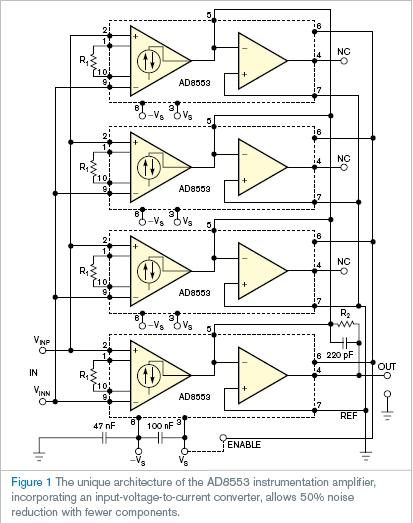Analog Devices AD8553儀表放大器的獨特架構(gòu)降低并聯(lián)設(shè)備噪聲。
Analog Devices AD8553自調(diào)零儀表放大器具有獨特架構(gòu),其兩個增益設(shè)置電阻沒有公共結(jié)點(參考文獻(xiàn)1)。IC的前端是一個精密電壓電流轉(zhuǎn)換器,其中一個增益設(shè)置電阻R1設(shè)置跨導(dǎo)的大小。IC的末端是一個精密電流電壓轉(zhuǎn)換器,它的反饋電阻R2的值,根據(jù)G=2(R2/R1)共同決定全部電壓增益。可以發(fā)現(xiàn),兩個增益設(shè)置電阻是獨立的,輸入端的電壓控制電流源,用減少放大器數(shù)量的方法,滿足嚴(yán)格的低噪聲要求。
多使用放大器減小噪聲分兩步。首先,假設(shè)放大器的隨機(jī)噪聲源相互獨立。進(jìn)一步,假設(shè)噪聲服從高斯分布。當(dāng)平均經(jīng)典電壓放大器的輸出時,通過使用N個放大器和三倍電阻減少噪聲到1/ (參考文獻(xiàn)2)。AD8553內(nèi)部架構(gòu)對幾乎無限個并聯(lián)IC工作時,僅允許使用N+1個電阻。通過并聯(lián)更多IC各自的輸入引腳,連接內(nèi)部電壓電流源容易并聯(lián)工作(圖1)。微伏級的輸入電壓偏置與若干IC的并聯(lián)輸入引腳配合不當(dāng)是無害的,因為電壓電流轉(zhuǎn)換器的輸出電阻理論上是無窮大的。

并聯(lián)N次輸入端的網(wǎng)絡(luò)結(jié)果是單IC輸出電流的N
(VINP–VINN)/(2R1)或N倍。可以僅使用N個IC電流電壓端的一個。端反饋電阻為R2/N,在此,R2為單IC的期望電壓增益AV值。由于放大器噪聲的主要來源為輸入端,假設(shè)N個并聯(lián)電壓電流轉(zhuǎn)換器輸出電流的隨機(jī)器件標(biāo)準(zhǔn)差為σNI=σI×![]() ,σI為電壓電流轉(zhuǎn)換器輸出電流的隨機(jī)器件標(biāo)準(zhǔn)差。這些結(jié)果與參考文獻(xiàn)2中的不同,文獻(xiàn)中作者通過多電壓平均的方法實現(xiàn)減小噪聲。另一方面,圖1電壓電流轉(zhuǎn)換器的共模輸出中電流的決定成分為單IC的N倍。下面的公式計算RSNR(相對信噪比),定義超過輸出噪聲標(biāo)準(zhǔn)差的輸出電流:RSNRN=(N×I)/(σI×
,σI為電壓電流轉(zhuǎn)換器輸出電流的隨機(jī)器件標(biāo)準(zhǔn)差。這些結(jié)果與參考文獻(xiàn)2中的不同,文獻(xiàn)中作者通過多電壓平均的方法實現(xiàn)減小噪聲。另一方面,圖1電壓電流轉(zhuǎn)換器的共模輸出中電流的決定成分為單IC的N倍。下面的公式計算RSNR(相對信噪比),定義超過輸出噪聲標(biāo)準(zhǔn)差的輸出電流:RSNRN=(N×I)/(σI×![]() )=
)=![]() ×RSNR1。實際上,意味著電路噪聲減少到單IC的1/
×RSNR1。實際上,意味著電路噪聲減少到單IC的1/ ![]() 。
。
英文原文:
Autozeroed amplifier with halved noise needs few components
The unique architecture of the Analog Devices AD8553 instrumentation amplifier permits paralleling devices to lower noise.
Marián Štofka, Slovak University of Technology, Bratislava, Slovakia; Edited by Charles H Small and Fran Granville -- EDN, 10/25/2007
The Analog Devices AD8553 autozeroed instrumentation amplifier has a unique architecture in that its two gain-setting resistors have no common junction (Reference 1). The first stage of the IC is a precise voltage-to-current converter, in which the first gain-setting resistor, R1, sets the magnitude of the transconductance. The end stage of the IC is a precise current-to-voltage converter, in which the value of its feedback resistor, R2, co-determines the overall voltage gain as G="2"(R2/R1). You can exploit the fact that the two gain-setting resistors are separate and that the input stage is a voltage-controlled current source to lower the component count in amplifiers with extreme noise-reduction demands.
You can use more amplifiers to reduce noise in two ways. First, assume that the sources of random noise in the amplifiers are mutually independent. Further, assume that the noise obeys a gaussian distribution. When averaging the outputs of classic voltage amplifiers, you can reduce the noise to a fraction of 1/ by using N amplifiers and three times as many resistors (Reference 2). The internal structure of the AD8553 allows you to use just N+1 resistors for an almost-unlimited number of ICs operating in parallel. By paralleling the respective input pins of more ICs, the connected internal volta
ge-to-current sources easily operate in parallel (Figure 1). The microvolt-range input-voltage-offset mismatch at paralleled input pins of several ICs is harmless here because the output resistances of the voltage-to-current converters are theoretically infinite.
The net result of paralleling N input stages is that they output current of N(VINP–VINN)/(2R1), or N times that of a single IC. You use only one of the current-to-voltage stages of the N ICs. That stage’s feedback resistor has the value of R2/N, where R2 is the value for a desired voltage gain of AV in a single IC. Because the primary source of noise in an amplifying IC is its input stage, you can assume that the standard deviation of the random component of output current of the paralleled-N voltage-to-current converters is σNI=σI×, where σI is the standard deviation of the random component of output current of a voltage-to-current converter. These results differ from those in Reference 2, in which the authors perform noise reduction by averaging multiple voltages. On the other hand, the deterministic part of current at the common output of the voltage-to-current converters in Figure 1 has the value of N times that of the single IC. The following equation calculates the RSNR (relative signal-to-noise ratio),
which you define as the output current over the standard deviation of output noise: RSNRN=(N×I)/(σI×)=×RSNR1. It means that, in effect, the noise of the circuit has decreased to a fraction of 1/ compared with that of a single IC.
References
“AD8553 1.8V to 5V Auto-Zero, In-Amp with Shutdown,” Analog Devices, 2005.
Štofka, Marián, “Paralleling decreases autozero-amplifier noise by a factor of two,” EDN, June 7, 2007, pg 94.

